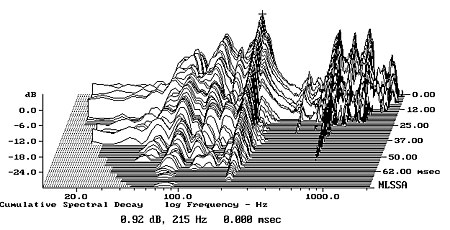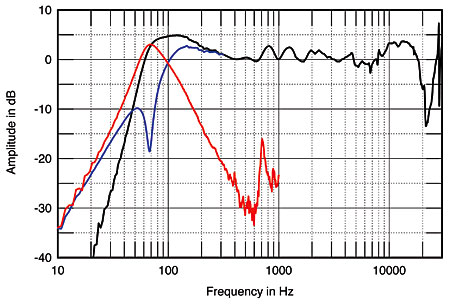| Columns Retired Columns & Blogs |
Infinity Primus P162 loudspeaker Measurements
Sidebar 3: Measurements
The Infinity Primus P162 plays surprisingly loud with very few amplifier watts, its estimated voltage sensitivity on its tweeter axis coming in at 89.5dB(B)/2.83V/m, which is within experimental error of the specified 90dB. The speaker is also a relatively undemanding load for the partnering amplifier, with an impedance that drops below 4 ohms only at the top of the audioband, and remains between 5 and 8 ohms much of the time (fig.1). Though the electrical phase angle reaches –45° at 125Hz, the impedance at this frequency is 10 ohms, alleviating the negative effect of the phase.

Fig.1 Infinity Primus P162, electrical impedance (solid) and phase (dashed). (2 ohms/vertical div.)
There are very slight wrinkles at 375 and 750Hz in the impedance traces, suggesting the presence of some kind of cabinet resonance at these frequencies. However, investigating the panels' vibrational behavior with a simple plastic-tape accelerometer uncovered some relatively high-level modes at lower frequencies (fig.2), which might contribute to the sense of "warmth" noted by BJR. Nothing was apparent around 400Hz, and while a mode was present at 730Hz, it was well down in level.

Fig.2 Infinity Primus P162, cumulative spectral-decay plot calculated from the output of an accelerometer fastened to the center of the cabinet's top panel (MLS driving voltage to speaker, 7.55V; measurement bandwidth, 2kHz).
Turning to the P162's acoustic behavior, there was a peak apparent just above 700Hz in the port's output (fig.3, red trace), but this is not high in level. The port's primary output peaks between 50 and 100Hz, and the corresponding minimum-motion notch in the woofer's output occurs at 68Hz, the center frequency of the low-frequency saddle in the impedance-magnitude trace in fig.1. These two traces, taken in the nearfield, are plotted in the ratio of the units' radiating diameters; their complex sum, taking into account magnitude and acoustic phase, is shown in fig.3 as the black trace below 300Hz. The broad peak in the upper bass will be mainly due to the nearfield measurement technique, but the woofer tuning does look a little underdamped, which correlates with Bob Reina's finding the P162's low-frequency balance to be a little generous, despite its lack of true bass extension.

Fig.3 Infinity Primus P162, anechoic response on tweeter axis at 50", averaged across 30° horizontal window and corrected for microphone response, with the nearfield responses of the port (red) and woofer (blue) plotted below 1kHz and 300Hz, respectively, and the complex sum of the nearfield responses plotted below 300Hz.
Higher in frequency in fig.3, the response trend is basically flat, but with a small top-octave peak and a smaller amount of boost in the upper midrange. The former will tend to balance the generous bass; all things being equal, the latter will both endow the speaker with a rather forward balance and enhance its presentation of recorded detail. These measurements were made with the P162's vestigial grille removed. Fig.4 shows the effect of the grille on the tweeter-axis response: the inevitable audioband ripples are relatively minor, at ±1dB. The larger changes above 20kHz won't be audible, of course.

Fig.4 Infinity Primus P162, effect on anechoic response on tweeter axis of adding grille (5dB/vertical div.).
The plots of the Primus P162's lateral and vertical dispersion (figs.5 and 6, respectively) were also taken with the grille removed. The lateral radiation pattern actually shows a slight lack of off-axis energy between 1 and 2kHz, which will work against the audibility of the on-axis peak in this region. Similarly, while the on-axis response has a slight suckout between 5 and 7kHz, this is balanced by an off-axis flare. However, the slight excess of on-axis energy between 2 and 3kHz will be reinforced by the off-axis flare in the same region.

Fig.5 Infinity Primus P162, lateral response family at 50", normalized to response on tweeter axis, from back to front: differences in response 90–5° off axis on port side of baffle, reference response, differences in response 5–90° off axis on other side of port.

Fig.6 Infinity Primus P162, vertical response family at 50", normalized to response on tweeter axis, from back to front: differences in response 45–5° above axis, reference response, differences in response 5–45° below axis.
In the vertical plane (fig.6), a severe suckout in the crossover region develops above and more than 15° below the tweeter axis. Stands should be used that will place the listener's ears level with the tweeter, if the low treble is not to sound hollow or lifeless. The P162 does produce a stronger treble "bounce" from the ceiling than usual; if you have a room with a low ceiling, this speaker might sound a little bright.
In the time domain, the Infinity's step response on its tweeter axis (fig.7) indicates that its two drive-units are connected with the same positive acoustic polarity, but that their outputs will be better integrated just below the tweeter axis. The P162's cumulative spectral-decay plot (fig.8) is relatively clean, but some ridges of delayed energy are evident in the mid-treble. This behavior might contribute to BJR's feeling that, at high playback levels, the speaker didn't sound as free of grain in the treble as he might have wished.

Fig.7 Infinity Primus P162, step response on tweeter axis at 50" (5ms time window, 30kHz bandwidth).

Fig.8 Infinity Primus P162, cumulative spectral-decay plot at 50" (0.15ms risetime).
Overall, and taking into consideration the fact that the Infinity Primus P162 costs just under $300/pair, its measured performance is surprisingly good. Its generous low frequencies and high sensitivity are bonuses for cash-strapped audiophiles.—John Atkinson
- Log in or register to post comments




































